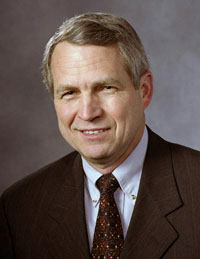2008-2009 Provost Lecture Series

Maintaining Affordability of Public Higher Education
Tuesday, October 14, 2008
1:30 p.m. to 3:00 p.m.
Fiedler Auditorium
Fiedler Hall
Dr. David E. Shulenburger
Vice President for Academic Affairs
National Association of State Universities and Land-Grant Colleges
Biographical Sketch:
David Shulenburger is NASULGC’s first Vice President for Academic Affairs. His immediate areas of concentration are on accountability and assessment in higher education and on the economics of higher education. Before joining NASULGC in June, 2006, David Shulenburger was Provost and Executive Vice Chancellor of the University of Kansas. He served there as chief academic officer for thirteen years. He came to the University in 1974 as an assistant professor and now holds the emeritus professor title. He received his Ph.D. and Masters degrees from the University of Illinois and his undergraduate degree from Lenoir Rhyne College. He previously served as a faculty member at Clemson University and as a labor economist for the U.S. Department of Labor.
His current research and writing focus on the economics of scholarly communications and of universities. He has been active nationally and internationally as an advocate for reform in the areas of accountability, scholarly communication and academic accreditation.
He was chair of the Board of Directors of the Center for Research Libraries from 2005-07, and is currently a member of that board, the National Commission on Writing, and a Consulting Editor for Change Magazine. He was Chair of the National Association of State Universities and Land-Grant Colleges Council on Academic Affairs in 2000-2001, a member of the BioOne board and of the Kansas Technology Enterprise Corporation..
David Shulenburger’s address is:
Vice President for Academic Affairs
National Association of State Universities and Land-Grant Colleges
1307 New York Avenue, NW, Suite 400
Washington, D.C. 20005-4701
Tele: 202-478-6062 ; Fax: 202-478-6061
Abstract:
The recent reauthorization of the Higher Education Act included a torrent of provisions intended to ensure the future affordability to students of U.S. higher education. They apply to all of higher education, but public and private higher education have very different cost drivers and affordability profiles. This presentation will focus on cost, tuition and affordability in the public sector of higher education and the actions that could be taken to ensure continuing affordability.